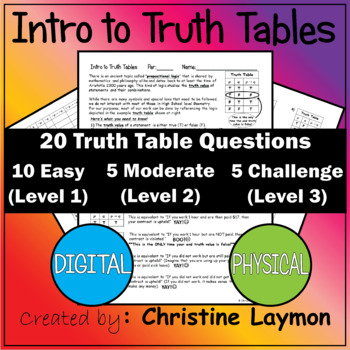Intro to Truth Tables
- PDF
- Easel Activity
Description
This activity teaches students how to evaluate truth tables which makes the basics of propositional logic accessible to high school students!
This activity deals with the conditional pattern p -> q, negation ~p, and the evaluation of the truth values of both simple and complex statements! This topic also lends itself to Discrete Math topics as well as to Philosophy.
NOTE: This activity does NOT cover De Morgan Laws, conjunction, or disjunction. Please see the Preview for examples of what this resource contains.
Contents:
- 4 student pages (non-editable PDFs) (enabled for EASEL by TPT as of 11/23/22) which includes:
- 1 highly detailed student Note Sheet with:
- 1) a topic intro
- 2) Vocabulary Definitions
- 3) How to Read a Truth Table coupled with an analogy to a Business Contract
- 1 highly detailed student Note Sheet with:
- 20 Truth Table questions appropriate for HS/Secondary Geometry
- 15 fill-in-the-table questions
- 10 Easy (Level 1)
- 5 Moderate (Level 2)
- 15 fill-in-the-table questions
- 20 Truth Table questions appropriate for HS/Secondary Geometry
- 5 Hard/Challenge (Level 3)
- Students have to create the appropriate truth table before filling it in.
- 5 Hard/Challenge (Level 3)
- 1 Teacher Contents and Details Page
- 1 Teaching Tips Page
- 1 Answer Key (3 pages)
Related Products:
- Check out "30-60-90 Special Right Triangles Bundle"
- Check out "Geometry Triangle Activity Resource Bundle" for all of my Triangle activities!
- Check out "Geometry Diagram Marking Activity" for a thorough walkthrough on how to mark and interpret geometric diagrams.
- Check out "Right Triangle Similarity" for a complete lesson
- Looking for more Geometry Resources? Check out what I have to offer!
---------------------------------------------------------------------
⭐ Earn TPT Credits! ⭐
- After you have used the resource (at least 24 hours after purchase), earn TPT Credits by going to My Purchases and then leaving Feedback/Reviews on the resource! More info can be found in TPT's FAQ here.
- Feedback on free resources is appreciated too but will not earn you credits.
Connect with me!
Questions? You can use the TPT Q&A feature for this product or email me at ChristineLaymon123@gmail.com
©2022-2024 Christine Laymon
Please note - this resource is for use by the purchasing teacher only.
Electronic distribution is limited to the purchaser's classes only. Please use this resource in the spirit that it is intended.






